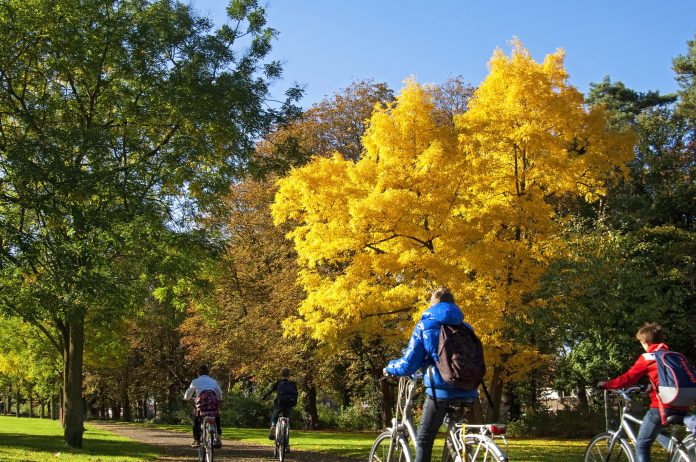Cycling to school can reduce air pollution and promote healthier choices, which could all be delivered by AI-powered insights
The first week of October marks Cycle to School Week, this year run by the Bikeability Trust and supported by Sustrans. It’s an initiative that echoes the necessity for our streets to be cycle friendly, forming part of the wider aim of creating smarter, safer and more sustainable towns and cities, says Mark Nicholson, Chief Executive Officer, VivaCity.
Over the last two years the UK has seen a cycling ‘boom’. The total value of the UK bicycle market was estimated to be around 47% higher in 2021 than in 2019, and the latest DfT Road Traffic Estimates suggest that cycle traffic in 2021 was 15.7% higher than pre-pandemic levels in 2019. Whether the motivation is because it is better for us or better for the environment, more people are getting on their bike. But with more of us joining cycle lanes, local authorities have had to invest in ways to make our cities and towns more cycle friendly and implement traffic monitoring solutions to aid this growth.
A survey by Sustrans found that only 2% of children cycled to school, with 10% wanting to
Furthermore, when it comes to the next generation of cyclists, a survey by Sustrans found that only 2% of children cycled to school, with 10% wanting to. 30% of UK children are ‘worried’ and 29% are ‘sad’ that vehicles on our roads make up the majority of greenhouse gases in the UK, with private cars forming the biggest part of this.
Air quality, emissions, congestion, and road safety targets are now of integral importance to local governments, communities and the next generation. So, finding methods of effectively creating network changes to encourage cycling growth are in high demand – and there’s a rising use of AI-powered insights helping to build infrastructure to support this, long-term.
The technology-LTN combination
Traffic monitoring solutions are aiding the support and growth of low traffic neighbourhoods (LTNs) across the UK, which are seeing significant increases in the number of cyclists. The goal of LTNs is to support active travel, clean air and safety by creating specific active travel zones and closures to vehicle traffic. In one LTN in the London Borough of Hounslow, for instance, cycle usage increased by 26% simply by restricting access to motorised vehicles.
Pollution and air quality sensors are a great way to monitor if LTNs and similar schemes are having a positive environmental impact in the area. The London Air Quality network , for example, monitors air quality across London boroughs, creating regular reports on pollution levels. These air quality sensors can also be set up to monitor how or whether specific LTNs or interventions have been able to improve air quality.
But this paints a picture of the general effects (that could be influenced by further external factors), and not the detailed specific use of such schemes. For this, councils need AI-powered technology to accrue objective data. Such technology enables councils to measure the precise impacts of their road and highway improvements.
By anonymously classifying road users – for example a cyclist or pedestrian passing through a specific point – councils can gather insights into the type, pattern and volume of traffic using each part of the road network. With this, they can effectively plan, implement and monitor current and future schemes.
Harnessing data to assess impact
Councils have been using these AI-powered sensors to gather anonymous data on various transport modes and, specifically, on cycling levels. This is enabling them to understand the impact of specific interventions on encouraging cycling and whether any improvements need to be made to facilitate it better.
For example, in August 2020, Bristol City Council closed Bristol Bridge – which served as a key access route for vehicles into the city centre – in order to monitor the effects it would have on encouraging people to use active and sustainable travel modes. Six AI-powered traffic monitoring sensors were subsequently installed to support an in-depth evaluation before the road changes became permanent in July 2021.
With this data, the council was able to accurately and effectively monitor the impact it had on cycling. Cycling levels grew following the easing of Covid-19 restrictions, with new highs recorded in spring 2022. Not only could they monitor peaks in travel but also the relationship between other external events happening in the city and factors like the weather.
Inspiring the next generation
An article by the FT exploring the pros and cons of LTNs highlighted that “a report by the International Energy Agency states that behavioural change will account for nearly two-thirds of the energy reduction needed to reach the net-zero goal.” It goes on to note that we’ll need to integrate more significant changes to people’s way of life and travel to achieve net-zero goals.
For this to work to its optimum potential, technology, data and people need to come together to effectively assess, plan and monitor networks, creating the best systems to support sustainable initiatives. With safer routes and cleaner air being delivered by schemes such as LTNs and road closures, the next generation is being encouraged to choose the bike, getting people out of cars and positively impacting the environment.
The demand for cycling is growing – and it needs to be met with the successful implementation of infrastructure changes to both facilitate it and inspire further uptake. For this to succeed, we need AI-powered data to deliver smart, safe and sustainable cycling.











